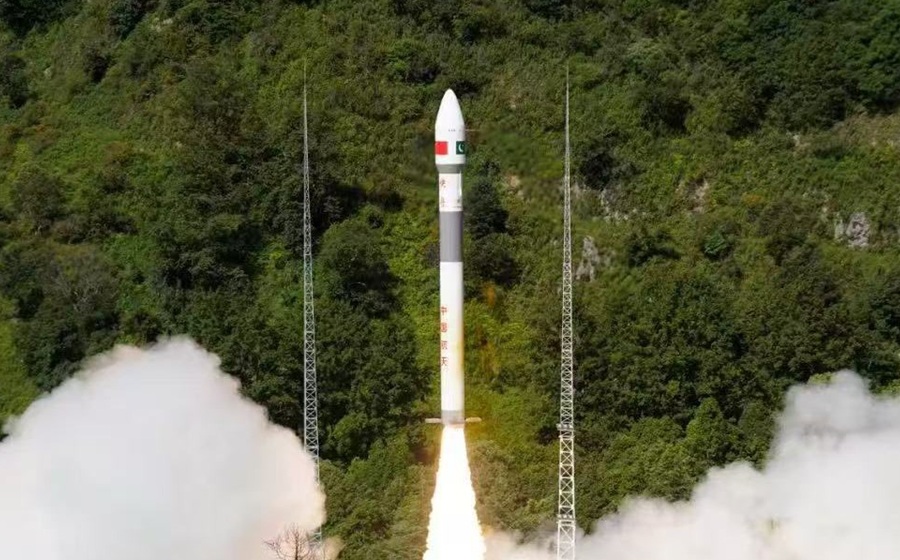Pakistan took a bold step forward in its space ambitions with the launch of PRSS-1 Earth observation satellite aboard a Chinese rocket, strengthening a decades-long partnership with Beijing, and laying the groundwork for a planned Pakistani lunar mission by 2035.
The Pakistan Remote Sensing Satellite-1 (PRSS-1) was successfully launched Thursday (July 31, 2025) morning aboard a Chinese Kuaizhou-1A (KZ-1A) rocket. The satellite soared into orbit from the Xichang Satellite Launch Center in China’s Sichuan Province at 10:00 a.m. Beijing time, signaling a significant milestone for both nations.
The mission marks China’s 29th flight of the Kuaizhou-1A launcher and represents a leap forward for Pakistan’s Earth observation program.
Pakistan’s Minister for Planning, Development and Special Initiatives, Ahsan Iqbal, who attended the launch event in China, said: “This is not just a technological milestone—it is a moment that lifts our national spirit and elevates our friendship with China higher than the skies.”
“Today, we are not merely launching a satellite, we are launching a vision that sees Pakistan rising as a leader in space science, powered by innovation, strengthened by partnerships, and driven by an unshakable belief in our destiny to be at the forefront of technology and exploration,” he added.
The minister also confirmed a long-term roadmap: “With China’s help, we plan to send a Pakistani astronaut into space next year. By 2035, we will also successfully complete our lunar mission and land on the moon.”
How will PRSS-1 benefit Pakistan?
The satellite, jointly developed by Pakistan’s national space agency SUPARCO and Chinese entities CETC and Microsat China, is equipped to deliver high-resolution, 24/7 imaging. It’s expected to enhance Pakistan’s capacity for urban planning, disaster mitigation, agriculture monitoring, and climate data analysis.
The satellite is the fourth Earth observation satellite launched by Pakistan and serves as a cornerstone in what officials described as an “integrated Earth observation system.” It will be pivotal for initiatives ranging from food security to deforestation tracking, offering valuable imagery for government agencies and researchers alike.
SUPARCO Chairman Mohammad Yousaf Khan emphasized that the satellite will “serve national priorities and contribute meaningfully to Pakistan’s sustainable socio-economic development.”
The launch also drew praise from Pakistan’s highest offices. Prime Minister Shehbaz Sharif congratulated SUPARCO and Chinese partners in a message benefit Psted on X, stating: “This achievement showcases the soaring heights of Pakistan-China cooperation, extending beyond borders and into outer space, driven by a shared vision to harness space technology for the betterment of humanity.”
President Asif Ali Zardari echoed the sentiment, calling the launch “a bright symbol of Pakistan’s growing space capabilities,” and commended the “capabilities of its scientists.” He also extended his gratitude to the Chinese government.
Deputy Prime Minister Ishaq Dar praised the collaborative spirit that made the PRSS-1 launch possible and commended the dedication of the engineers, scientists, and technical teams from SUPARCO Pakistan and CETC & MICROSAT China for their exemplary cooperation and unwavering commitment to the mission.
Pakistan, China expand Space Cooperation
The launch of PRSS-1 is just one piece of a broader and fast-expanding collaboration between Pakistan and China in space science.
Astronaut Program: In February this year, Pakistan became the first foreign nation to formally join China’s crewed space program. Under a landmark agreement signed in February 2025 between SUPARCO and the China Manned Space Agency, two Pakistani astronauts began training at the Astronaut Center of China. One will eventually serve as a scientific payload specialist aboard the Tiangong space station, marking Pakistan’s entry into human spaceflight and reinforcing the two countries’ shared commitment to long-term exploration.
Satellite launches: China has launched multiple Pakistani satellites, including one sent into lunar orbit during the Chang’e-6 mission to the far side of the moon in 2024.
China’s space program is rapidly advancing, from reusable rocket tech to the steady growth of the Tiangong space station and the expanding BeiDou navigation system. Pakistan is now riding that momentum, leveraging the partnership to accelerate its own capabilities. With projections placing the global space economy at over $1 trillion by 2040, Pakistan’s investments today are a stake in tomorrow’s technological economy.
Ahsan Iqbal summarized this trajectory: “Great nations don’t just dream of the stars, they build the rockets to reach them. With innovation as our compass, collaboration as our engine, and determination as our fuel, Pakistan and China will together touch the Moon, explore Mars, and unlock the limitless opportunities of the universe.”









